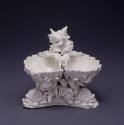Triple shell dish
Dateca.1770
Maker
English, Plymouth
Label TextMassive, complicated structures such as the triple shell dish are more stable, in both modeling and firing, when produced in hard-paste rather than soft-paste porcelain. This dish was produced at the first hard-paste factory in England, which was established in 1768 by William Cookworthy (1705-1780), a Quaker and noted chemist, who discovered the essential ingredients of kaolin and porcelain stone in Cornwall.
Object number57.85
Exhibition HistorySeattle, Washington, Seattle Art Museum, "Porcelain Stories: From China to Europe", February 17, 2000-May 7, 2000 (2/17/2000 - 5/7/2000)Published ReferencesFinlay, Robert. "The Pilgrim Art: Cultures of Porcelain in World History". Berkeley, Los Angeles and London: University of California Press, 2010, illustrated pl. 7
Emerson, Julie, Jennifer Chen, & Mimi Gardner Gates, "Porcelain Stories, From China to Europe", Seattle Art Museum, 2000, pg. 221
The Art Quarterly, Autumn 1957, p. 323, illus. p. 322Credit LineBlanche M. Harnan Ceramic Collection, Gift of Seattle Ceramic Society, Unit 1
Dimensions6 3/4 in. (17.1 cm), height to top of bowls
MediumHard paste porcelain













 log in
log in



